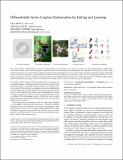Differentiable Vector Graphics Rasterization for Editing and Learning
Author(s)
Li, Tzu-Mao; Lukac, Mike; Gharbi, Michael; Ragan-Kelley, Jonathan
Download3414685.3417871.pdf (16.83Mb)
Publisher Policy
Publisher Policy
Article is made available in accordance with the publisher's policy and may be subject to US copyright law. Please refer to the publisher's site for terms of use.
Terms of use
Metadata
Show full item recordAbstract
We introduce a differentiable rasterizer that bridges the vector graphics and raster image domains, enabling powerful raster-based loss functions, optimization procedures, and machine learning techniques to edit and generate vector content. We observe that vector graphics rasterization is differentiable after pixel prefiltering. Our differentiable rasterizer offers two prefiltering options: an analytical prefiltering technique and a multisampling anti-aliasing technique. The analytical variant is faster but can suffer from artifacts such as conflation. The multisampling variant is still efficient, and can render high-quality images while computing unbiased gradients for each pixel with respect to curve parameters.
We demonstrate that our rasterizer enables new applications, including a vector graphics editor guided by image metrics, a painterly rendering algorithm that fits vector primitives to an image by minimizing a deep perceptual loss function, new vector graphics editing algorithms that exploit well-known image processing methods such as seam carving, and deep generative models that generate vector content from raster-only supervision under a VAE or GAN training objective.
Date issued
2020-11-26Department
Massachusetts Institute of Technology. Computer Science and Artificial Intelligence LaboratoryJournal
ACM Transactions on Graphics
Publisher
ACM|SIGGRAPH Asia 2020 Technical Papers
Citation
Li, Tzu-Mao, Lukac, Mike, Gharbi, Michael and Ragan-Kelley, Jonathan. 2020. "Differentiable Vector Graphics Rasterization for Editing and Learning." ACM Transactions on Graphics, 39 (6).
Version: Final published version
ISBN
978-1-4503-8107-9